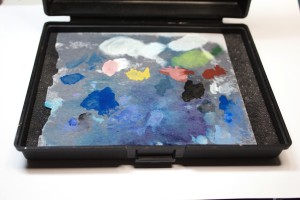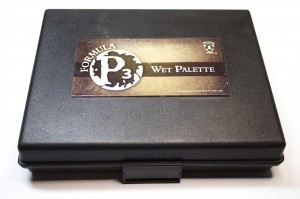 I’ve used all kinds of palettes in the past, ranging from plates, tiles, porcelain cups and plastic bits and bobs. They all had the same issue, the paint dried up quickly even when thinning down the paints (faster during summer days).
I’ve used all kinds of palettes in the past, ranging from plates, tiles, porcelain cups and plastic bits and bobs. They all had the same issue, the paint dried up quickly even when thinning down the paints (faster during summer days).
Using these materials as a palette, I would find that I would be constantly bringing more paints from the pots on to the pallets only for it to dry up faster as the paint under it would go dry and crust up. Mixing paints was also a major headache as I would have to try to keep getting the exact consistency every time with each new mix due to the last mix on the palette drying up.
Enter the Wet palette. I’d heard about this concept for some time on the internet and the accolades it was receiving, but never really ventured into making one. Then several years back at a convention, I cam across a prefabricated one by Formula P3. I took it home and gave it a try that day. The very next day I sped back to the final convention day,stocked up on more palette and papers (so much that it would last several years) and never used another type of pallet again!
The Wet palette is essentially a parchment paper (the palate surface) that sits on top of a soaked spunge. How it works is that the paint absorbs moisture through the paper and dries a lot slower than using other materials. The P3 Forumla Wet Pallet comes with a lid that allows you to seal the palette away for later use (I’ve come paints fresh in it for weeks).
The Wet Pallet concept is amazing. Whether you make your own or purchase prefabricated ones, it is a must tool in your painting arsenal. I have several of the Formula P3 wet pallets on hand at any one time when paining. I use each pallet usually for a different project (where I may be running several projects at once), and seal it up for later use when I’m done.
You can make your own wet pallet by purchasing some simple Bakers Parchment paper, wet both sides of it and placing it on a soaked spunge. Simple as that.

